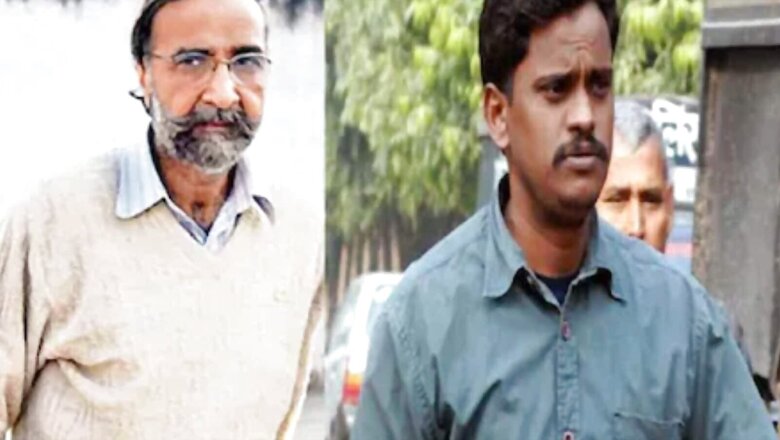
views
After a series of murders shocked in Madhya Pradesh, the tale of an ‘angry youth’ surfaced.
While serial killings are most associated with the stories vehemently narrated in US pop culture, it might not be well known that India has had its own shocking ‘serial killer’ cases, with the latest one an addition to the gory list.
An 18-year-old school dropout accused of killing four security guards in six days in the MP cities of Sagar and Bhopal was a loner who harboured unexplained “anger” since his childhood, reports later said.
Shivprasad Dhurve, alias Shiva and Halku, the alleged serial killer, was identified from his Aadhaar card and arrested by police on Friday. He lives in Kekra village in the Sagar district.
According to police, he targeted sleeping security guards and killed three of them in Sagar district and one in Bhopal. The first three killings occurred within 72 hours of each other earlier in the week, while the fourth victim, from Bhopal, died just hours before Dhurve was apprehended.
As details from the case continue to shock, News18 takes a grisly walk down the most chilling serial killing cases in India, and a deeper delve into the most recent one:
‘Cyanide Mohan’: The Man Who Would Disguise Poison Pills as Contraceptives
Mohan Kumar, or ‘Cyanide Mohan’ as he would come to be called, would trick women into taking contraceptives that were actually cyanide pills after having sex with them. He murdered approximately 20 women between 2005 and 2009. He is also said to have been involved in bank frauds and other financial forgeries. He was sentenced to death in December 2013.
He was accused of luring women who couldn’t afford dowry or couldn’t find suitable husbands. He would murder them by giving them cyanide pills disguised as contraceptives and robbing them of their jewellery.
‘The Nithari Kand’
The Noida serial murders (also known as the Nithari serial murders or Nithari Kand) occurred in 2005 and 2006 in the home of businessman Moninder Singh Pandher in Sector-31, Noida, near Nithari village, UP.
Moninder Singh was convicted in two of the five cases brought against him, and his servant Surinder Koli, who assisted him, was convicted in ten of the sixteen cases brought against him. They were both sentenced to death.
The case was fraught with chilling details of murdered and missing children, and supposed cannibalism as well.
Two Nithari village residents reported in December 2006 that they knew the whereabouts of the remains of children who had gone missing in the previous two years: the municipal water tank behind house D5, Sector-31, Noida. They both had missing daughters and suspected Surinder Koli, the domestic help at D5, was involved in the disappearances. Residents claimed that local authorities had repeatedly ignored them, so they sought the assistance of former Resident Welfare Association (RWA) President S C Mishra.
Mishra and the two residents searched the tank drain that morning. After one of the residents claimed to have discovered a decomposed hand, the police were called.
Parents of children who have gone missing in the last two years rushed to Nithari with photographs. Koli later confessed to killing six children and a 20-year-old woman known as “Payal” after sexually assaulting them under the alias Satish.
On December 26 and 27, Koli’s employer, Moninder Singh Pandher, and Koli were arrested in connection with the disappearance of “Payal.” Following Koli’s confession, the police dug up the nearby land area, where they discovered the bodies of the children.
Allegations of a child pornography racket, organ trade, necrophilia and cannibalism made news. While some of these claims were dismissed as rumours, investigators did not deny the possibility of others.
Charles Sobhraj: ‘The Bikini Killer’
Between 1975 and 1976, Charles Sobhraj murdered approximately 12 people in various parts of South East Asia. Sobhraj, unlike other killers, used to kill his victims and then rob them of their money to fund his lavish lifestyle. He would gain the trust of his potential victims by rescuing them from a problem that he had caused.
He was dubbed the “Bikini Killer” after the bodies of two women in floral bikinis were discovered. He was apprehended in India and imprisoned from 1976 to 1997. He was later arrested in Nepal in 2004, and he is now serving his second life sentence.
The ‘Delhi Butcher’ Who Liked Taunting Police
A new crime series refocused national attention on a serial killer who dismembered his victims before dumping their bodies across the national capital. Chandrakant Jha, a serial killer, was convicted of his crimes, which included taunting and challenging police to catch him before he struck again.
Jha, a migrant labourer from eastern Bihar state, committed his first murder in 1998, but the case against him was eventually dropped due to a lack of evidence, despite the fact that he was arrested and held in jail for four years.
Between 1998 and 2007, Chandrakant Jha (born 1967) befriended, then murdered and dismembered 18 victims in west Delhi. His first murder occurred in 1998, for which he was arrested and imprisoned until 2002, when he was released due to a lack of evidence. Following his release, he went on a killing spree. Shekar and Umesh came first in 2003, followed by Guddu in 2005, Amit in 2006, and Upender and Dalip in 2007.
He would make friends with migrant labourers from Bihar and Uttar Pradesh and assist them in finding small jobs. Later, petty disagreements over things like theft, lying, or being a non-vegetarian would lead to him strangling them to death.
Chandrakant enjoyed taunting the police by leaving dismembered body parts around the city and outside the Tihar Jail with notes, daring the cops to apprehend him. In February 2013, he was found guilty on three counts of murder and received two death sentences as well as life imprisonment until death.
In January 2016, his death sentences were commuted to life in prison without the possibility of parole. His parole application was denied in January 2022.
Raman Raghav or the ‘Jack Reaper of India’
Raman Raghav, also known as ‘Pyscho Raman,’ terrorised Mumbai’s slum dwellers in the 1960s. He used to kill his victims with a baton.
He was diagnosed with schizophrenia when he was arrested, but he confessed to killing 23 people. His confession, however, was highly suspect given that he was not mentally stable. In 1995, he died of kidney failure.
How it Happened
In August 1968, a series of murders occurred on the outskirts of Mumbai. While sleeping, pavement and slum dwellers were bludgeoned to death. All of the murders were committed at night and with a hard, blunt object. A similar series of murders had occurred in Mumbai’s Eastern suburbs a few years earlier (1965-66). In that year, as many as 19 people were attacked, with 9 of them dying.
Raman Raghav was arrested after police suspected him. He was a homeless man who had previously been mentioned in police files and had spent five years in prison for robbery. The police let him go because no solid evidence could be found against him for the new set of crimes. When the killer struck again in 1968, police went on the hunt for him. Ramakant Kulkarni, then the Deputy Commissioner of Police CID (Crime), took over the investigation and led a massive citywide combing operation. The police were successful in arresting him in this attempt.
In his confession, he admitted to murdering 41 people along the GIP (Great Indian Peninsular Railway, as the Central Railway (India) was then known) line in 1966 and nearly a dozen in the suburbs in 1968. He most likely killed many more people. In Mumbai, there was widespread public anxiety and panic. Slum and apartment dwellers dreaded sleeping outside or with open windows and balconies.
The Latest Killing
In the latest case, Dhurve, a labourer who worked at many places including Maharashtra, an official said.
Khajuri Murder: Dhurve killed Sonu Verma (23), who was a security guard in a marble shop in the area, by hitting him with a marble pillar in Khajuri area of Bhopal on Thursday night, said local police station in-charge Sandhya Mishra.
Sagar Murder: His first murder was in Sagar city, about 170 km north of Bhopal, where he killed Kalyan Lodhi, who was in his 50s and worked as a guard at a factory, on the intervening night of August 28-29. Lodhi’s head was smashed with a hammer.
Third Killing: Shambhu Narayan Dube (60), who was on duty as security guard at an arts and commerce college, was killed on the intervening night of August 29-30 under Civil Lines police station limits. His head was found smashed with a stone, police said.
Fourth Murder: Mangal Ahirwar, watchman at a house, was killed in Moti Nagar area on the intervening night of August 30-31 after being attacked with a stick.
Read all the Latest News India and Breaking News here




















Comments
0 comment